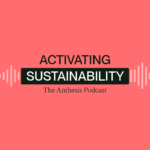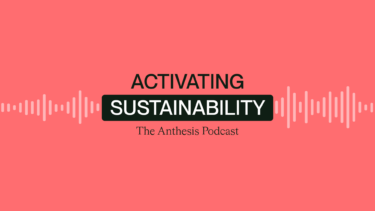
Speakers
Debbie Hitchen – EMEA Lead for Sustainable Products, Packaging & Circularity
Afsaneh Nabifar – Head of Global Advocacy and Sustainability for Biopolymers, BASF
Maria Holopainen – Business Lead on Circular Economy, Stora Enso
Related Topics
Share this episode
In this episode of our Activating Sustainability series, our host Debbie Hitchen is joined by guests Afsaneh Nabifar of BASF and Maria Holopainen of Stora Enso to explore the circular economy in the packaging sector with a focus on the innovative “Compostable by Design Platform.” The conversation highlights the challenges and opportunities in making compostable packaging a viable solution across Europe, emphasising the need for cross-value chain collaboration to scale organic recycling and improve sustainability in packaging.

Read the transcript
Debbie Hitchen: Hello and welcome to this episode of the Anthesis podcast series. My name is Debbie Hitchin and I’m the regional lead for EMEA for Sustainable Products Packaging and Circularity and I’m delighted to be joined today by two external guests, Afsaneh and Maria, who are going to introduce themselves and their organisations in just a moment.
So I’ll come back to them in a minute and just give them an opportunity to tell you more about themselves. But by way of introduction to what we’re going to be talking about. today. Our conversation is going to be exploring the circular economy through the lens of the packaging sector. So during this this session, we’re going to be asking our guests a bit more about the drivers for circularity and sustainability strategies specifically in relation to packaging.
And we’ll be taking a look into an innovative collaborative program called the Compostable by Design Platform, which is unique in Europe. So very excited to have that opportunity to welcome our guests. and to get their insights and some thoughts around this topic. So firstly let’s meet our guests.
Afsaneh, welcome to the podcast. Could I ask you to go first and just tell us a little bit about yourself by way of introduction and something about your organisation and your current role, please.
Afsaneh Nabifar: Thanks for having me. Good afternoon, everyone, or good day, good morning, wherever you are all around the world. My name is Afsaneh Nabifa. I’m a chemical engineer by training. I have a PhD in polymer science and engineering. I’ve joined BSF, uh, 2012 and have had severalpositions over the years in R and D department or in business development, marketing, and since three years I’m leading the global team for sustainability and advocacy for biopolymers.
And I’m involved and represent BSF in several different associations in packaging for example Comp SeaFlex or Forever Green or a European Bioplastic Association, British Bioplastic Association. And since October last year, I have the honor of chairing the new foundation, Compostable by Design Platform.
Debbie Hitchen: Thank you. Delighted to have you with us. And there’s so much in there that I already want to get in and start asking questions around. But before we get started, Maria, lovely to hear from you as well. If you could tell us a little bit about yourself and your current role at Stora Enso, that would be lovely.
Maria Holopainen: Thank you. My name is Maria Holopainen and I work as a business lead on circular economy at Stora Enso. What comes to Stora Enso we are a leading provider of renewable products in packaging, biomaterials, as well as wooden construction.
Stora Enso has approximately 20, 000 employees and last year our sales was 9.4 a billion euros. What comes to my current role at Stora Ensa, I am responsible for developing circular solutions with partners across the value chain to have products that are designed for circularity, as well as I contribute to improving collection and sorting of fiber based packaging to give those valuable materials also a second life to either mechanical or organic recycling.
I believe it’s not enough that packaging is recyclable. It also has to be recycled at scale. And that’s why working towards the needed systemic change together with partners representing the whole value chain. Is crucial. And besides being a member of the steering group of Compostable by Design Platform, I also work as co lead in Information Workstream in Forever Green, that is a cross -industry alliance, having more than 100 members representing the entire lifecycle of fibre-based packaging.
I have my background within strategy, business development and innovation and in my today’s or daily work, I have the pleasure to combine all the experience and expertise in the field of clean technologies, low carbon energy, as well as circular bioeconomyp. A leasure to be with you today.
Debbie Hitchen: Thank you for joining us. Having presented the Wise Women in Waste podcast since the COVID pandemic where we profiled the opportunities for women to become leaders in our sector. I just think it’s fascinating to hear the different pathways that you’ve both taken to get to the roles that you’re at the moment, and hopefully something that people will take away from this is the different ways in which we can come into this sector of packaging and sustainability and influence it with different chemical backgrounds and different experiences, different pathways into our careers.
So really exciting to hear a little bit about your roles and maybe to dive in over the course of this next conversation to how you got into those roles and what inspires you around the sustainability and circular economy agendas as we go through this conversation.
But just before we, we get into the meat of things, Afsaneh, I’m not sure if people are familiar with BASF, and I was just wondering if you could tell us a little bit more about the organisation.
Afsaneh Nabifar: So, BSF is the world’s leading chemical company. We have more than 112, 000 employees globally, and we are active along the entire value chain of chemicals and provide products to nearly all the sectors. Yeah, I usually joke with my family that B. S. F. is everywhere you look. So my husband doesn’t like it so much because he says I combined too much of work in my life.
But you know, if I work for a chemical company that provides almost everything, it’s difficult to differentiate or separate myself because I’m constantly looking at things that we have contributed in making. So we, for example, have beside of course the typical petrochemical Yeah.
Let’s say the chemical petrochemical background we supply products into nutrition and care agricultural solutions to surface technologies, coatings and of course plastic and foam business, which then my department is located. So I belong to the biopolymers department within the plastic division.
Debbie Hitchen: And when did your sort of personal interest in sustainability start?
Afsaneh Nabifar: I think basically I’ve always been quite passionate about sustainability but had actually all along my career in BSF had something to do with packaging. So I have to say sustainability in packaging is close to my heart. So through the different roles that I have had within BSF I have had for example, starting from printing inks.
So resins that are going into printing inks. Then I have seen the adhesives the fiber and paper coating applications, polyamide applications, and now biopolymers. It’s interesting to see that you can have Of course, different solutions, but everybody’s end goal is actually yeah basically the company’s goal is that we create chemistry for a sustainable future.
So whatever we do, we try to combine economical success with environmental protection and social responsibilities, but also using science and innovation to meet the needs of the society and our customers.
Debbie Hitchen: I’ve been in waste initially and then in packaging and sustainable products for decades, longer than I want to admit to. But I think it was quite interesting that, it really landed on the sort of global agenda through things like the blue planet series when talking about your husband, my family said to me, ‘oh, we finally get it.We understand what you do now, Debbie. We understand what sustainable packaging is.’
So maybe this is a good point to bring Maria in. So Maria in Stora Enso, what’s the role of sustainability in, what’s the importance of it in your business model?
Maria Holopainen: Well, in terms of Stora Enso as the renewable materials company, we can say that our roots are deep in the forest. So that brings also sustainability. Really at the core of what the company does. We believe that Stora Enso has a great opportunity to contribute to the needed transformation towards a bio based circular economy.
And particularly there we focus on three areas where we have the biggest impact but also the biggest opportunities and those are climate change, biodiversity and circularity. In terms of what Stora Enso can and will do is that we can contribute to this transition towards the circular bioeconomy by offering regenerative solutions.
And what does this then mean? We make products that are being recycled. We remove more CO2 than what we emit, and we enhance biodiversity. And while saying this, I don’t mean that we are there yet, so it will be a journey. And our direction is clear, and this is where we have our emphasis on.
Debbie Hitchen: I love the use of the word journey. I think sustainability should always be described as a journey because we should always be looking for that next opportunity, that continual commitment to improvement. But it’s interesting that the landscape has shifted over the last few years, or certainly within the last five or six years.
And I think there’s a lot of action within the global landscape, which is driving significant change actually all the way through the value chain in packaging. And I wondered if you could give us a little bit of an insight perhaps Afsaneh to start with at the global level about what it is that Specifically in that landscape, in that global landscape, that’s influencing the packaging agenda at the moment around sustainability topics.
Afsaneh Nabifar: Yeah. So I would like to make this very personal actually, because it’s for me, interesting having been in this space almost for 12 years, it is interesting exciting times at the moment because we see a lot of movement in the packaging industries. I think some years ago, let’s say five, six years ago, when we were talking with our customers, their main wishes was having a better performance, whether it’s higher oxygen barrier, better improved tear strength or better sealability, these were the main wishes of the customers. But since couple of years now, we are seeing in addition to this technical requirements, quite a lot of wish for circularity sustainability dimensions in the conversation, which I believe it’s really driven by the environmental concerns and the, consumers preferences that are shifting.
So we are, of course witnessing quite several global legislations on the packaging. Which encourages the companies to adopt circular packaging practices. We see, globally, quite a lot of legislations on single use application or single use packagings in Europe, also in Canada, UK, the US. We see legislations on packaging tax or EPR programs to drive the recycling and to generate a market for recycled material.
And yeah, of course, everybody since 2021 is talking in Europe about PPWR, so I think we have been breathing and leaving this document for the last yeah, let’s say almost two years now and yeah, we are very much looking forward to its implementation and what it brings. But I think it’s also interesting dynamics that this new legislation space offers is also going towards looking at different technology advancements, realising that maybe one needs innovative recycling technologies to develop more, for example, efficient sorting technologies, but also technologies like like black block chain to improve the traceability or movement of circular materials through the value chains.
I believe this is quite Interesting times, but also the industry realising that one really needs this cross collaborative activities along the value chain to really be able to make an impact. So I think this is quite unique times that we are seeing. So I think that the relationships are really changing from being just an, for example, for us, being just a material producer, we are suddenly becoming a partner in developing end of life solutions. So I think for us it’s quite interesting times.
Debbie Hitchen: Yeah, it’s interesting to see that term product stewardship, which has been banded around probably for a couple of decades, actually really coming into fruition. You know, this joining of collaborative partnerships, working outside the usual suspects and creating new upstream and downstream value chains that allows that product stewardship to actually have a long term impact, I think is really interesting.
Yeah. I’m conscious that we’ve used, actually, so far, quite a lot of acronyms in this podcast. And ASECT is really bad for this. It’s like an alphabet soup. I wonder if we could maybe just dive in a little bit more and unpack what’s in PPWR and maybe coming to you, Maria, a little bit more context around how this lands specifically in the European region?
Maria Holopainen: Thank you. Besides being an acronym soup, it has also been a legislative tsunami, as some say. And of course it all derives back to the European Green Deal, which was announced by the European Comission Already in 2019 and that is, of course, a set of policy initiatives where the overarching aim is to make the European Union climate neutral in 2050.
Ambitious goal which needs then a lot of actions to to reach that goal. And one of the main priorities has really been the circular economy. And there also then the eyes turn to the sustainable transition of the packaging value chain. So within the Circular Economy Action Plan 2.0 there were already more detailed targets. And there was also the revision of Packaging and Packaging Waste Directive highlighted back in the days, which is or was the major piece of legislation for the whole packaging sector. Nowadays, we know the former Packaging and Packaging Waste Directive as Packaging and Packaging Waste Regulation so the known PPWR.
And that is really like a comprehensive framework to prevent packaging waste and also to promote reuse and recycling in order to accelerate the transition towards a more circular economy. Now, of course, what is happening we have the Packaging and Packaging Waste Regulation out and it still needs the final approval both from the newly elected parliament as well as the council end of this year.
And then the Packaging and Packaging Waste Regulation is expected to enter into force by 2026. It has. A lot of different policy measures. For example recyclability assessment, as well as eco modulation, what comes to extended producer responsibility, EPR fees. Then there are the packaging waste reduction targets, as well as mandatory labeling.
There is also packaging minimization. Recycled content target for plastics different recycling targets for materials as well as reuse and refill targets, and then some bans regarding some specific packaging formats. Many things will change, and a lot will happen before The Packaging and Packaging Waste Regulation is truly implemented across the Europe.
Debbie Hitchen: So it’s really clear to see how that then is setting a context within which organisations need to address their circularity and their sustainability strategies for packaging. But then that brings me to the question about why Compostable by Design Platform. So if I come to you first, Afsaneh, because you were part of the sort of founding partners for that program.
What was it about this regulation that encouraged your organisations to take that step?
Afsaneh Nabifar: Yeah, I think it was basically, as BSF we try to offer our customers solutions that can help them not only recycle, but also reduce and reuse. As a packaging we as a company are quite neutral towards different recycling technology. So we, we have, for example, quite a lot of activities with customers on mechanical recycling, chemical recycling and of course, organic recycling, which is quite relevant for specific applications like compostable packaging applications. And we recognise that compostable packaging is especially relevant for food contaminated or food soiled packaging. But of course, this is also with the realisation that it’s not a silver bullet for ending problems with plastic waste or plastic pollution in the environment, but it’s really a piece of puzzle along with other recycling solutions to reach a full circularity for the packaging sector.
And we really acknowledge that, yeah, in order to really make this big scale organic recycling of compostable packaging happening, we really need the involvement and embracement of the whole value chain in order to make this a big scale practice. Of course, we see different areas within Europe that this is already a well practiced waste management system. For example, in Italy, we have a quite a big compostable packaging market. Organic recycling is well established and even EPR schemes are existing for compostable packaging. But yeah, this is quite different islands here and there that one sees and it’s not really a big scale in Europe. So therefore we recognise that there is a need to basically work with the whole value chain to basically take the barriers and actualise the potential value of compostables that can offer.
Debbie Hitchen: And obviously both your organisations have got different types of packaging, different types of business model. So Maria, were the motivations for Stora Enso joining Possible by Design Platform similar or were there other drivers also that sort of drew you to that collaborative platform?
Maria Holopainen: At Stora Enso particularly what comes to packaging materials they are already today, recyclable. However, we know that not always the materials also get recycled. uh, What comes to paper and cardboard based packaging also known as fiber based packaging today already more than 80 percent of fiber based packaging is recycled in Europe.
Which makes actually paper and cardboard the most recycled. packaging material today. However what Afsaneh was also highlighting sometimes because of, for example, food contamination or the environment where certified compostable materials are being used they do not allow or promote material traditional mechanical recycling or they don’t make it possible.
So that’s why we see that organic recycling provides an additional complementary end of life solution for certified compostable materials. And that also makes the work of the platform so important.
Debbie Hitchen: Yeah. Thank you. I think it’s a very interesting conversation there. So let’s understand a little bit more about the vision of the platform. Perhaps again, as Asani is you have a co-chair role within the platform. Can you explain a little bit more about what its vision and objectives are
Afsaneh Nabifar: Basically, our main goal is to ensure that compostable material or packaging are accepted for organic recycling at scale in Europe. I want to help improve the circularity of material that are contaminated with food waste, or are likely to end up being disposed of with the organic waste. And we would really like to aspire to establish pathways for compostable material to be processed by the right technology providers and infrastructure. Would like to be a platform for collaboration and innovation in compostable material technologies and processes. And we hope that we can provide with our collective knowledge guidelines and also evaluation protocols to drive innovation and clear communication around the concept of compostable material.
And we want to advance, optimise collection and recycling systems for compostable materials and inform and engage the consumers, industry and policy makers. As I said, I think in some countries like Italy the concept of compostable material are well understood versus in other countries it’s something a bit mysterious, maybe sometimes not well understood. So we hope that with our collective the knowledge from the whole value chain, not because we have members, not only from the resin producers or packaging producers, but also waste management and, composting associations.
So we really hope that collectively we can bring this insight towards different stakeholders.
Debbie Hitchen: And I think what really drew Anthesis part of the reason that we’ve been involved with you and why we’re hosting this podcast with you is because of that activation. So it’s that vision to actually take this to something that is driving a different business model, a different way of resolving the circularity within this type of packaging.
And maybe perhaps to that theme, Maria, could you tell us a little bit more about some of the work streams that are going on that are firstly, the ones that we’ve got active at the moment, and maybe a little bit also about the vision for where you’d like to go in the future.
Maria Holopainen: This aim as you said, we do have work streams all together, five of them and three of them are currently the most active.
Namely the Workstream 1, which is focusing on developing a framework and best practice for field testing compostable products. Then we have Workstream 2 that is focusing on designing guidelines. for compostables, as well as then Workstream 3, which is focusing on collection and recycling guidelines.
Also Workstream 4, which will then in the future look more into innovation, is something that has been designed, but not yet implemented, as well as then Workstream 5, which has been more dedicated to supporting the technical work streams by the means of communication. And then if we look at a bit more in detail what the three most active work streams are doing.
So, what comes to the Workstream 1, there really, the ambition is to establish a framework, for moving towards the harmonised disintegration protocol for field testing within Europe. And there also the idea is to contribute to the update of the EN 1, 3, 4, 3, 2 standard, as well as then other discussions in this field.
And that is indeed to work towards the acceptance of compostable materials in composting facilities. And then when looking at the Workstream 2 there the ambition is to identify best practice as well as draw up the most comprehensive guideline for the design of combustible packaging and products.
And that is, of course, very important in the very beginning of the life cycle of packaging, so that when packaging designers are making decisions about what kind of materials and compositions they are going to use in the packaging, they make it compostable throughout the packaging from the beginning.
Then in terms of Workstream 3 that is about collection and recycling guidelines. And there we will start with mapping the current infrastructure and performance of the collection and recycling facilities, what comes to composting in Europe to ensure that we have the needed knowledge and stakeholder engagement
Maria Holopainen: to ensure that combustible materials are recycled at scale across Europe.
Debbie Hitchen: And these work streams are contributed to by the members or the sponsors as they’re called in the platform, aren’t they? So what is it, that makes this platform worth or different, worth their time and energy and their investment because obviously they’re putting their own sort of intellectual stamp on some of this work.
Why do organisations choose to do that?
Maria Holopainen: It’s really the power of collaboration. We’re also Compostable by Design Platform is unique. It’s really that all the segments of combustible materials the value chain are represented. So we have resin producers, we have film manufacturers, we have paper and board producers, then we have packaging converters, brands and retailers are there, also logistics providers, as well as, of course, organic waste management and treatment providers, without forgetting certification bodies, as well as testing labs, And then academic institutions and beyond.
It’s really the collaboration, which is at the core of the platform, and that’s that’s where we build on our excellence.
Debbie Hitchen: And it’s great to see that diversity of stakeholder group is coming together. I suppose, it might lead people to ask, how do I get involved in it? Cause there’s always room for more within this group, I imagine. Afsaneh, how would somebody find out a bit more about it or get engaged with this if it was something of interest to their organisation?
Afsaneh Nabifar: Yeah, so we already have a website. So if you would like to, somebody likes to learn more, it can visit our website, www.compostablebydesignplatform.com
And there, there is also an email contact that they can get in touch with us. But also people are interested to meet up face to face. I will be at Smithers Sustainability in Packaging Europe conference on behalf of Compostable by Design Platform in Barcelona in October and Maria will be present at Green Blues Sustainable Packaging Coalition engagement event in Amsterdam in November, representing the platform. So I’m sure if anybody from the packaging sector is interested to reach out to us they can reach out via also LinkedIn to Maria and I to set up a meeting.
Debbie Hitchen: Well, that’s super useful to know. Thank you. And I could ask a million other questions, but I’m going to have to draw it to a close. So I’ll start by just saying an enormous thank you to you both for sharing your insights and your experience with us. But I’d like to ask just one last question before we draw this discussion to a close, to both of you.
And I guess it is looking back, if you were in 2030, so you’d been transported forward in time and you’re looking back, what do you think success for sustainable or circular packaging would look like at that point?
Yeah, so interesting question, Debbie I wish I had a to say how to say the glass ball?
Debbie Hitchen: A glass ball, yes.
Afsaneh Nabifar: to see into the future. But yeah, I think I hope that basically by 2030 we would have made a significant progress in eliminating unnecessary packaging reducing packaging waste by a better product design as well as the implementation of efficient waste management systems because I think one has to realise it’s not only about the product design but also efficient implementation of the waste management that needs to go hand in hand to make an impactful progress. And we hope that we see the scale up of innovating innovative recycling technology which could then contribute towards higher recycling race for all different materials. So as Maria said, for some materials like paper, we are already in towards quite good numbers, but there are some other materials that are lacking behind for several reasons, and we really hope that with this new innovating recycling technologies, that we can really close the gap and actually reach the recycling quotas that have been defined already in Packaging and Packaging Waste Directive back in 2018. So I think the aim or the wish is to have something like 65% recycling for plastic packaging. And I think Maria, is it 85% for paper?
Maria Holopainen: Correct, yeah.
Afsaneh Nabifar: and I think basically the main aim is to reduce the dependency on the virgin resources and transition towards a renewable and, or recycled material. And of course, we hope to see adaptation of biodegradable and compostable packaging solutions in applications that make sense. And also the use of more innovative new material and packaging solutions that maybe they are at the moment in their infancy.
Debbie Hitchen: That’s pretty comprehensive. I feel very positive. I would like to join you in that vision of 2030. Maria I don’t know if She’s left you much else. Is there anything else that you would define in your vision of success? If you’re looking back in six years or so.
Maria Holopainen: It’s not that far away. So I, I believe that particularly in those areas where we need to sort of, excel tomorrow we can do it. So first, of course, we need to start with having packaging, which is designed for recycling, and if that is not yet happening, then that is definitely something that’s that we should guarantee. And also what I believe in is that this packaging, which is designed for recycling, it is also on its way to be collected, sorted and recycled at scale across Europe.
What Afsaneh was already saying is that indeed some materials are performing better than the others. Also, some countries are doing better than the others. I would like to see everyone succeeding. So we should not compete, but definitely we should collaborate and we should do it at a European level.
And where I see we have an opportunity and we are already on the right track, is that this systemic change which is needed it’s enabled by collaboration across the packaging value chain, while contributing to the transition of a circular bioeconomy.
Debbie Hitchen: So I believe that we will actually have the framework that you’re both describing. I think we have investment and we have technology potential. I think if I was going to add anything to your visions of success, it would be the right consumer behaviours. So the piece of the jigsaw puzzle, I think that we need to just complete that vision that you’re talking about is the consumer engagement, the consumer awareness and understanding at end of life.
So with any luck, we will get there. I have enjoyed our conversation. And I think, there’s a great demonstration here of different organisations coming together. And Maria, you said it very nicely just now, not competing, but collaborating in a shared space, in a shared interest where both environment and society gains from having a more sustainable outlook on how we create circular packaging.
So I just want to say an enormous thank you both for sharing your time, sharing your insights and taking us on some of the journey from your day to day experiences. It’s been great to hear from you. We will post some of the information about where people can get involved with the Compostable by Design Platform.
So thank you for sharing that information with us as well. And I wish you both a brilliant rest of the day.
Afsaneh Nabifar: Thank you, Debbie.
Maria Holopainen: Thank you.
Debbie Hitchen: Well done. Thank you all very much for listening. Please take a look at the Anthesis website for more episodes of the Anthesis podcast and look out for next month’s episode.
Inside this episode
- What are the drivers of circularity and sustainability in packaging
- What is PPWR, and how has the packaging regulation landscape changed in recent years
- What is the Compostable by Design Platform, and what are some of its objectives
- What are some of the challenges and opportunities in making compostable packaging a viable solution across Europe
- How to get involved in the Compostable by Design Platform
If you have any feedback on the podcast, get in touch with our host Chris Peterson at: Chris.Peterson@anthesisgroup.com















